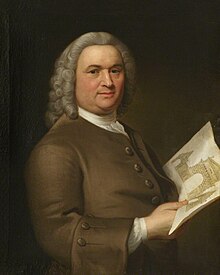Matthew Brettingham | |
|---|---|
 Brettingham in a portrait by John Theodore Heins, 1749 | |
| Born | 1699 |
| Died | 19 August 1769 |
| Occupation | Architect |
| Buildings | |
Matthew Brettingham (1699 – 19 August 1769), sometimes called Matthew Brettingham the Elder, was an English architect who rose from modest origins to supervise the construction of Holkham Hall, and become one of the best-known architects of his generation. Much of his principal work has since been demolished, particularly his work in London, where he revolutionised the design of the grand townhouse. As a result, he is often overlooked today, remembered principally for his Palladian remodelling of numerous country houses, many of them situated in the East Anglia area of Britain. As Brettingham neared the pinnacle of his career, Palladianism began to fall out of fashion and neoclassicism was introduced, championed by the young Robert Adam.
Born in Norwich, into a family of craftsmen, Brettingham worked initially as a surveyor, gaining experience through jobs for the city's civic authorities. Work included restorations at Norwich Cathedral, at the castle, at the local prison and the shire hall. His professional ascent began in 1743 with his appointment to the post of Clerk of Works at Holkham. The succeeding decades saw many aristocratic commissions, predominantly in East Anglia, but including work at Kedleston Hall in Derbyshire.
In addition to designing their country houses, Brettingham developed a substantial practice in the construction of town houses for the aristocracy. Major commissions included Norfolk House and Cumberland House. Drawing inspiration from Italian urban palazzo, and from Andrea Palladio's rural villas, he created a style and arrangements of rooms perfectly suited to the lavish entertaining undertaken by the mid-18th century nobility. Here, as in the country, he was ultimately superseded, and his reputation eclipsed, by the rise and success of Robert Adam. Brettingham died in 1769. His son, Matthew Brettingham the Younger, also pursued an architectural career.